Media Shuttle’s Metadata Input Capabilities
Signiant introduces Metadata Everywhere, a new series about our innovative Software-Defined Content Exchange (SDCX) architecture and how it facilitates interactions with both media essence and metadata across disparate and distributed storage environments.
As a media asset makes its way through the supply chain, much of its associated metadata is generated automatically or assigned programmatically. But people remain deeply involved in many parts of the content creation and distribution process, and sometimes metadata is best captured directly from the media professionals who interact with the asset along the way. The metadata input by people is often simple descriptive or contextual information that defines the content or supports its transition to the next workflow step. For example, a cable network or OTT provider will want to ensure that production partners provide the season number and episode number along with the program master when they deliver each part of a series. Individuals responsible for sending the finished work are well positioned to provide this information, but they need a simple mechanism for doing so.
Media Shuttle, Signiant’s widely-deployed SaaS solution for person-initiated transfers, is often used to move assets from one lifecycle step to the next ⎯ so it makes sense to append metadata capture to this familiar tool. Media Shuttle’s metadata collection functionality is associated with Submit portals, one of three portals types available in the product (the others are Send and Share). Submit portals allow end users to deliver content to a fixed storage location, for simple aggregation purposes and/or to be picked up by an automated service for downstream processing. Customers can integrate their own tailored metadata collection forms with these portals so that they appear harmoniously within the Shuttle interface and provide end users with an easy means of entering the required information.
The Challenges of Collecting Metadata From People
Whenever people are directly involved in the metadata input process, the potential for human error rears its head. While tight operating procedures and prescriptive processes can mitigate the situation, it’s also important to make the experience as simple as possible for end users, to minimize frustration and maximize compliance. At Signiant, we’re attuned to the range of issues that can occur when people enter metadata and have designed Media Shuttle to help our media customers alleviate them.
Here’s how we address some common challenges:
Incomplete or missing information: In time-critical operations, it can be disastrous if a media asset arrives at its destination with insufficient metadata. With Media Shuttle, it’s easy to use metadata form completion as a workflow gate. The system can be configured so that the asset cannot be uploaded until all of the required information has been entered into the form.
Data errors: It’s simple to implement a generic, boilerplate data input form and instruct users to enter information in each field. But data entry errors are virtually impossible to eliminate, so in high-stakes applications it’s considered as best practice to design a custom form. Just replacing manual data entry with a pull-down menu yields very high dividends in data integrity, and many companies take things a step further with advanced human factors work to optimize the end user experience. To meet these needs, Media Shuttle gives customers the flexibility of incorporating a customized form for every Submit portal.
Missing or incorrect links between essence and metadata: When file details and descriptions are delivered in an ad hoc fashion, such as via an accompanying email, it’s easy for metadata to become disconnected from the asset it references. Missing or irretrievable metadata isn’t available for querying or to be referenced by downstream systems. Worse yet, metadata wrongly attributed to an asset can lead to an array of serious problems in the content delivery process. The patented SDCX SaaS architecture that underpins Media Shuttle is ideally suited for maintaining linkages between media assets and their associated metadata.
How Signiant’s SDCX Architecture Enables Seamless Metadata Collection
Signiant’s Software-Defined Content Exchange (SDCX) architecture directly enables our versatile approach to gathering metadata from end users as part of a file submission workflow. The SDCX architecture has two major system components: an intelligent cloud control plane that oversees file transfer processes, and a data plane that facilitates the movement of content between storage locations. Think of the control plane as handling metadata while the data plane deals with media essence. With these two system components operating in coordination, Media Shuttle is readily able to establish and maintain a relationship between an asset and its metadata.
The control plane orchestrates the movement of content and serves the web interfaces through which end users initiate transfers and administrators authorize users and track activity. This is where integration between the Media Shuttle user interface and a metadata form takes place. Signiant’s flexible approach gives customers the choice of serving a metadata form from their own web server or using a serverless cloud-based application, and we provide the hooks for embedding the form within the Submit portal interface. In addition to handling these web interface tasks, the control plane is where metadata is stored after it’s collected. Meanwhile, the media essence itself moves between storage locations via the SDCX data plane. Using a Submit portal, Media Shuttle enables the fast, secure transfer of content between a web client on the end user’s computer and the customer’s on-premises or cloud-based storage location. This core file transfer activity happens in concert with metadata input, where the two actions are coordinated and the relationship between essence and metadata is maintained.
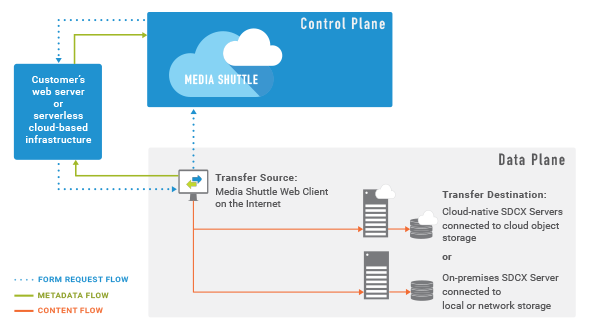
Ensuring Secure Content and Metadata Transmission
Whether it’s content flowing from source to destination on the data plane or metadata moving to Media Shuttle on the control plane, Signiant always ensures the security of valuable media assets and all their associated machine- and human-generated data.
Signiant’s multi-layered approach to security includes both policy and technology strategies guided by a set of secure design principles. Signiant engages independent third parties on a regular basis to perform thorough security reviews of its products and services.
With specific regard to Media Shuttle’s metadata collection feature, Signiant has taken care to develop a secure signing process that provides the following protections:
- Verification that the party requesting the form has the correct permissions
- Use of key request elements in calculations to secure data in transit
- Inclusion of a timestamp component to protect against replay attacks
What the User Sees in a Metadata-Enabled Portal
Once a portal administrator enables metadata collection with the click of a checkbox and the entry of the customer’s metadata URL (the address from which the customer’s form is served), end users can input metadata via Media Shuttle. When an end user opens the interface for a portal enabled with metadata collection functionality, they’ll first see the familiar, intuitive layout of a Submit portal and any custom branding chosen by the portal’s administrator.
The one noticeable difference? A button to add information.

The user can add files as usual, but will be prevented from uploading them until any metadata entry requirements designated for the portal are met.

Upon clicking the Add Info button, the metadata collection form will open directly inside the portal browser window.
Once information is entered and any metadata validation steps required by the customer are complete, the form can be closed and the end user can submit the content for transfer to the destination.
Customizing Your Metadata Entry Form
Just as the look of any Media Shuttle portal can be customized to include a company’s logo and brand colors, so too can the metadata form. Designing a complementary look provides a seamless and trustworthy experience for Media Shuttle users, who will immediately recognize a company’s hallmarks.
When it comes to content and appearance, the range of creative possibilities is wide. Naturally, the particulars of your audience and use case will guide the inclusion of certain data fields and design elements on the custom form you develop.
To demonstrate some of the achievable results, here are some examples of metadata collection forms inspired by those currently in use by Media Shuttle customers.
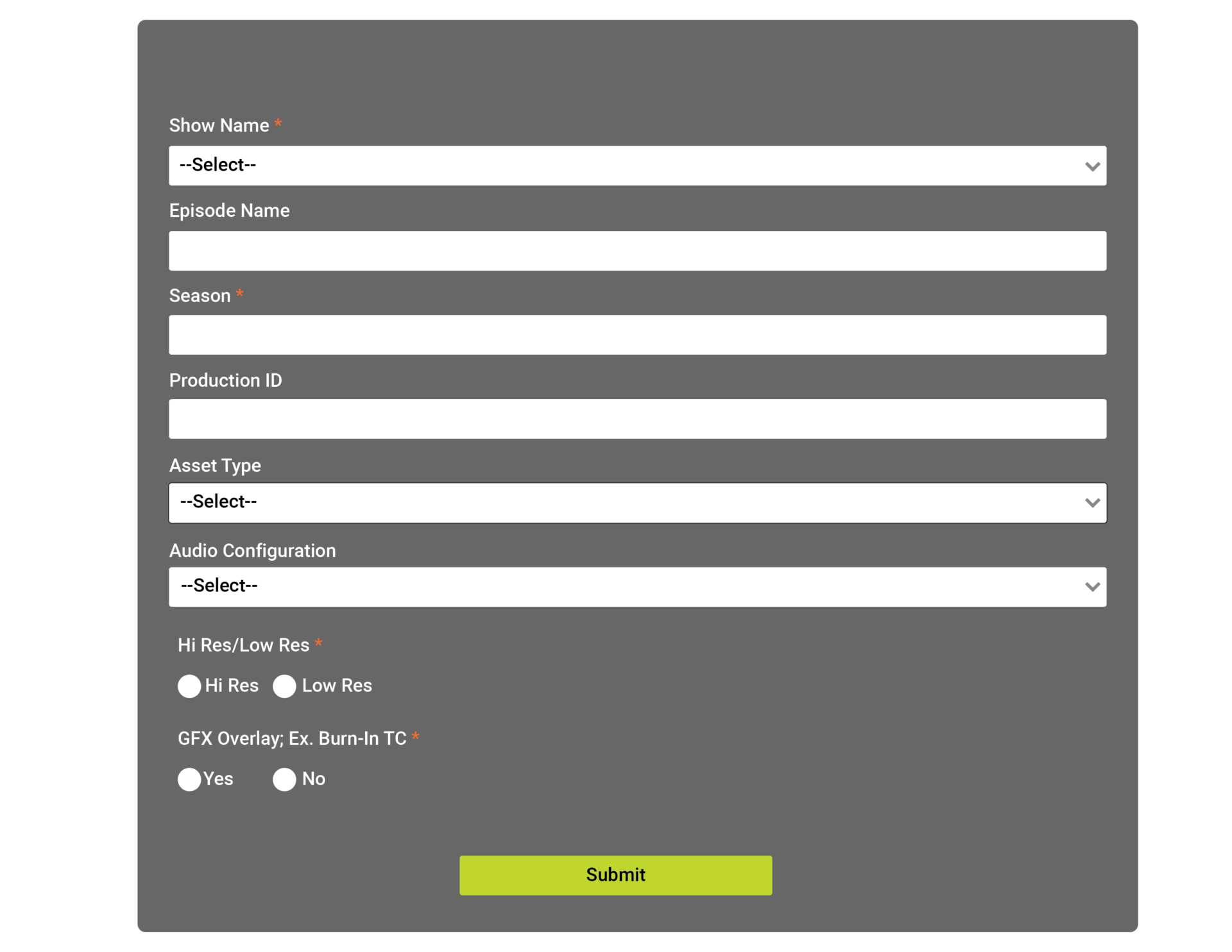
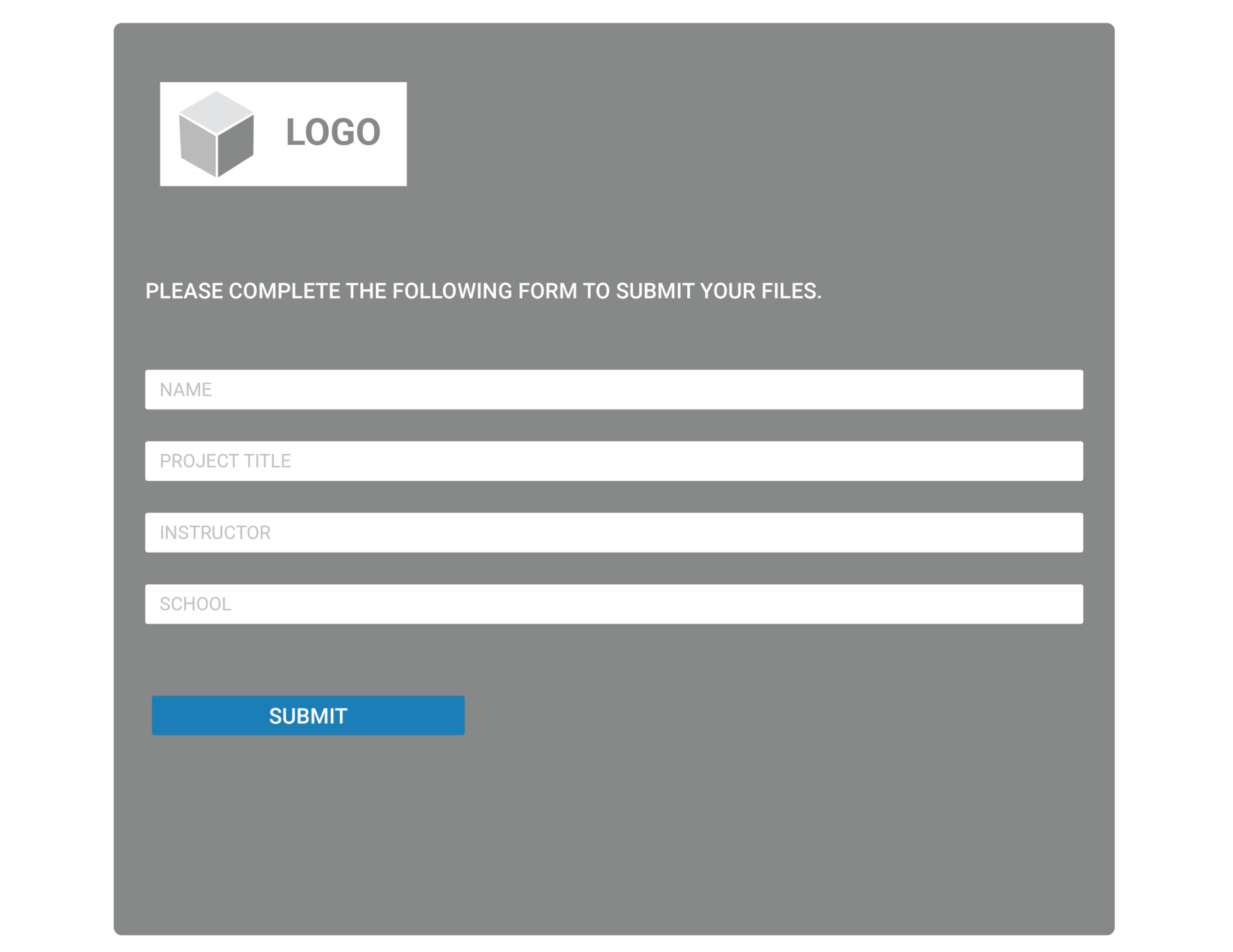
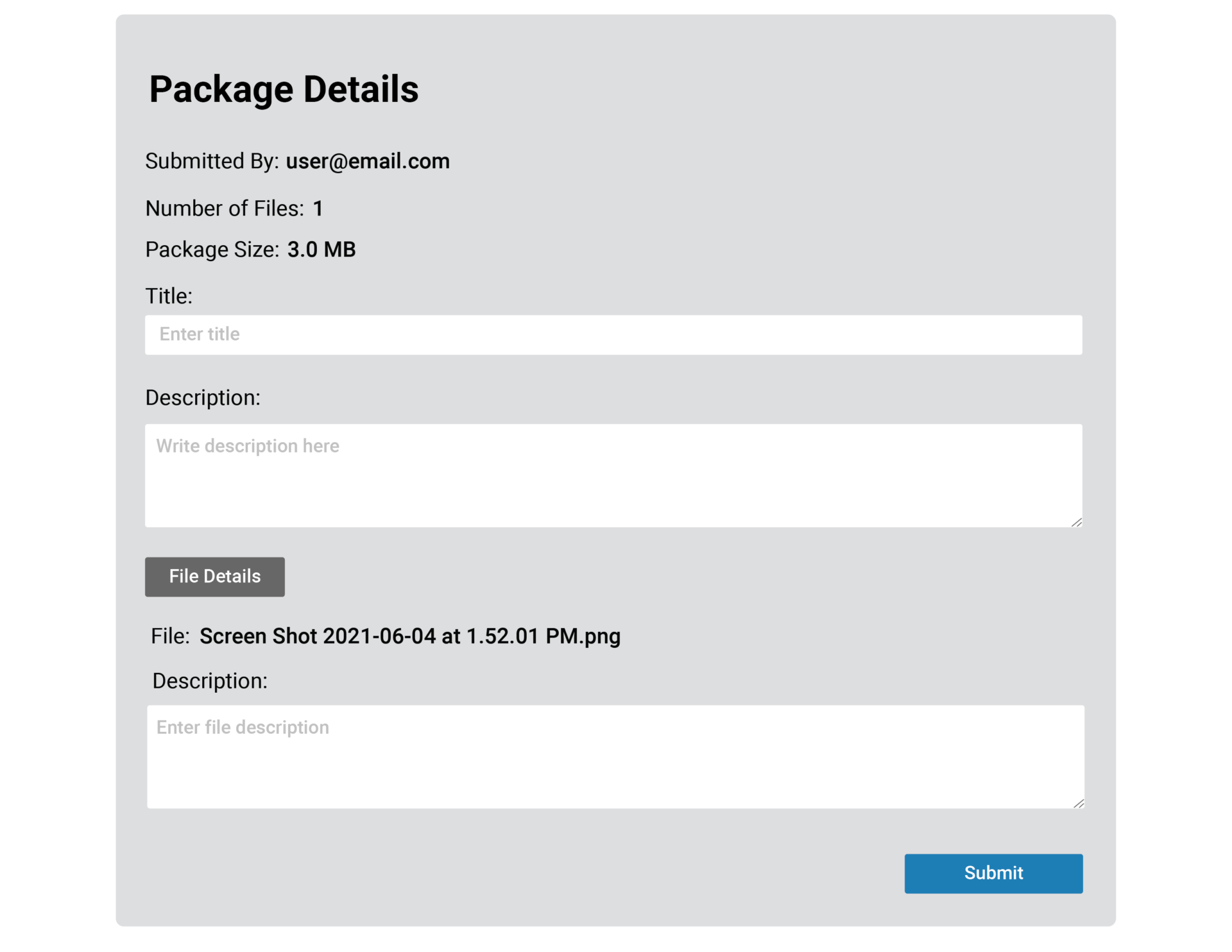
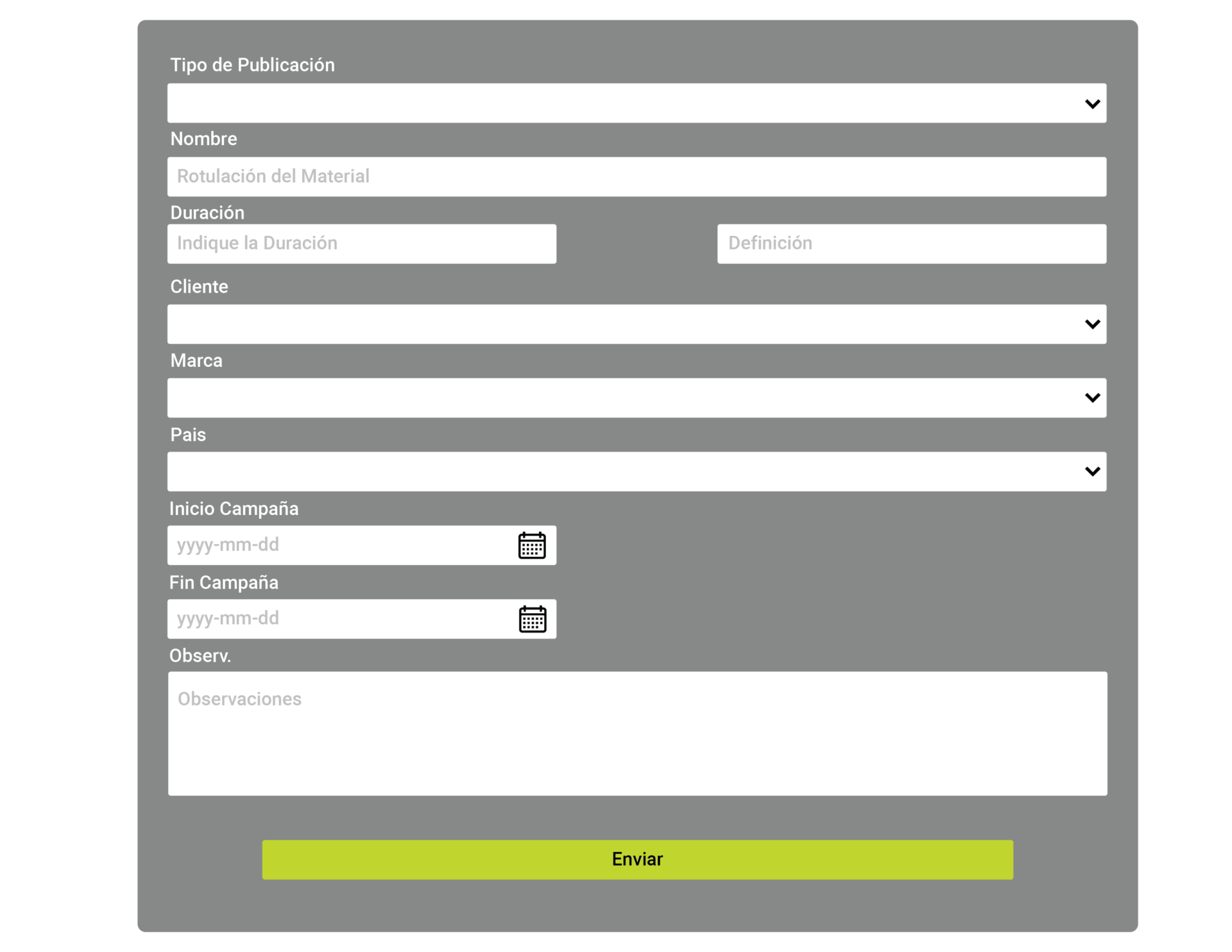
Behind the Scenes in a Metadata-Enabled Portal
While the end user experiences a fluid interaction that moves easily from the Submit portal to the customer’s metadata form and back, there are a number of tasks occurring behind the scenes to deliver the form and collect the entered data.
Here’s what happens:
…when the end user adds files and clicks the Add Info button…

…and when the user’s entered information has met any required validation and they click the Submit button

Once collected metadata arrives for storage within the customer’s infrastructure or Media Shuttle, it becomes available for querying and further referencing, even before the file transfer is complete.
Signiant’s versatile solution for metadata input by people
Modern media workflows are highly dependent upon accurate and complete metadata, some of which comes directly from end users. With Media Shuttle, Signiant helps media and entertainment companies move beyond the use of inflexible, generic data input forms and implement robust solutions to optimize operational efficiency and data integrity.
Media Shuttle’s metadata collection capabilities:
- Intrinsically maintain the link between an asset and its metadata
- Give an organization’s technical administrators the freedom to produce custom forms that minimize data entry errors, collect exactly the right information, and are tuned for their end users
- Make it easy to configure processes that enforce metadata entry prior to allowing content to be uploaded
- Ensure that both your valuable content and its associated metadata arrive quickly, securely and reliably at their intended destinations
Signiant’s metadata collection feature is included with all enterprise-level Media Shuttle subscriptions. If you’re considering the addition of a metadata-enabled Submit portal, Signiant would be happy to assign a technical advisor who can discuss potential implementation strategies, help plan out the right solution, and guide its successful deployment.
This brief is the sixth installment in our series, Metadata Everywhere. Other chapters explore, in more depth, the ways in which Signiant’s SDCX SaaS architecture works with the media essence and metadata across disparate and distributed storage environments. Learn about the many different ways media organizations can utilize the Signiant metadata framework to enhance productivity and optimize their technology stack.


